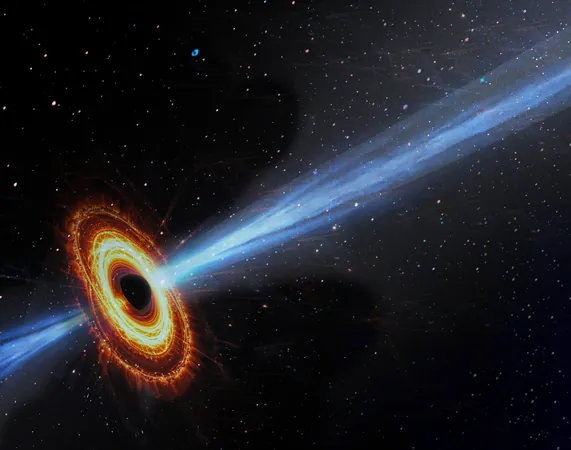
Exploring the Unraveling Mysteries of Black Hole Jets with the Event Horizon Telescope
2025-03-24
Author: Siti
Introduction
In a groundbreaking study, an international team of astronomers has leveraged the capabilities of the Event Horizon Telescope (EHT) to gain unprecedented insights into the dynamic jets emitted by supermassive black holes. This collaborative effort involved multi-wavelength observations of active galactic nuclei, revealing how these enigmatic celestial giants propel their powerful jets into the cosmos.
The EHT and its First Campaign
During its inaugural campaign in 2017, the EHT focused on sixteen distinct sources, allowing researchers to examine these jets closer to the black holes than ever before. Led by Jan Röder from the Max Planck Institute for Radio Astronomy (MPIfR) in Bonn, Germany, and the Institute of Astrophysics of Andalusia (IAA-CSIC) in Granada, Spain, the findings have been published in the prestigious journal Astronomy & Astrophysics.
Research Goals
The research aimed to deepen our understanding of jet acceleration and magnetization. By employing observations from the EHT and comparing them with data from the Very Long Baseline Array (VLBA) and the Global Millimeter VLBI Array, which sample larger spatial scales, the researchers were able to trace jet evolution from the black hole's immediate vicinity to interstellar distances spanning several light-years.
Challenging Traditional Models
“Our results challenge long-standing perceptions of jet behavior,” stated Röder. “By analyzing this diverse sample of active galactic nuclei, we reduced the influence of peculiarities inherent to individual sources, revealing a more cohesive view of jet dynamics.”
Traditionally, jets have been modeled as conical structures with plasma moving at a constant velocity. However, this study indicates that such a simplistic view may only apply to a small fraction of jets. The intricate details of jet sub-structure and dynamics raise questions about the validity of existing models, as differing geometrical orientations can create the illusion of acceleration when, in fact, it may be a result of the jet's angle relative to the observer.
Observations and Findings
Co-leader Maciek Wielgus chimed in, highlighting an important trend observed: "The brightness of jets typically increases with distance from the black hole. This strongly hints at jet acceleration, suggesting complex mechanisms at play."
The work emphasizes the significant role of intermediate-scale observations, as Eduardo Ros from MPIfR explained. “The Global Millimeter VLBI Array, particularly at a wavelength of 3.5 mm, serves as a bridge between the ultra-high resolution of the EHT and broader jet characteristics revealed through the VLBA. Such insights are crucial, exemplified by the case of the black hole M87.”
The Significance of Active Galactic Nuclei
Active galactic nuclei epitomize the vibrant and powerful cores of some galaxies, fueled by supermassive black holes. Their plasma jets stretch tens of thousands of light-years into the vastness of intergalactic space, showcasing some of the universe's most significant physical phenomena. As astronomers push the boundaries of observational technology, they are now able to probe the inner workings of these jets—an endeavor necessitating extreme angular resolution.
The Role of the Event Horizon Telescope
The Event Horizon Telescope acts as a global array of radio telescopes, effectively combining them into a single virtual telescope the size of Earth. This innovative approach provides the necessary resolution to study black holes and their jet dynamics comprehensively. Previously, the EHT made headlines by capturing the first-ever images of supermassive black holes located at the centers of the Milky Way and M87.
Ongoing Challenges in Jet Evolution Understanding
However, understanding the evolution of jets remains a complex challenge. The current study juxtaposed EHT findings with earlier observations to clarify the progression of jets departing their origins, revealing that the brightness temperature—and therefore the radiative power—tends to rise as the jets extend further into space.
“Despite the wealth of data, alternative interpretations exist,” Röder cautioned. “The basic theoretical models cannot capture the complete picture surrounding jet properties close to their source. More extensive studies are essential to unravel mechanisms behind the acceleration, energy flow, and magnetic field roles in these active galactic nuclei.”
Collaborative Research in Astrophysics
According to J. Anton Zensus, director at the MPIfR and one of the founding leaders of the EHT collaboration, the results accentuate the importance of collaborative research, advanced technology, and innovation in the realm of astrophysics. He stated, “These findings highlight the ongoing efforts of the EHT and validate the complementary findings from the Global Millimeter VLBI Array. With upcoming telescopes and next-generation networks, we are poised to further illuminate the mysteries surrounding these astounding cosmic phenomena.”
Conclusion
With the cosmos as their relentless canvas, scientists are on the path to unlocking deeper understandings that could reshape our comprehension of black holes and their fierce jets, continuing to dazzle and intrigue stargazers around the globe.


 Brasil (PT)
Brasil (PT)
 Canada (EN)
Canada (EN)
 Chile (ES)
Chile (ES)
 Česko (CS)
Česko (CS)
 대한민국 (KO)
대한민국 (KO)
 España (ES)
España (ES)
 France (FR)
France (FR)
 Hong Kong (EN)
Hong Kong (EN)
 Italia (IT)
Italia (IT)
 日本 (JA)
日本 (JA)
 Magyarország (HU)
Magyarország (HU)
 Norge (NO)
Norge (NO)
 Polska (PL)
Polska (PL)
 Schweiz (DE)
Schweiz (DE)
 Singapore (EN)
Singapore (EN)
 Sverige (SV)
Sverige (SV)
 Suomi (FI)
Suomi (FI)
 Türkiye (TR)
Türkiye (TR)
 الإمارات العربية المتحدة (AR)
الإمارات العربية المتحدة (AR)